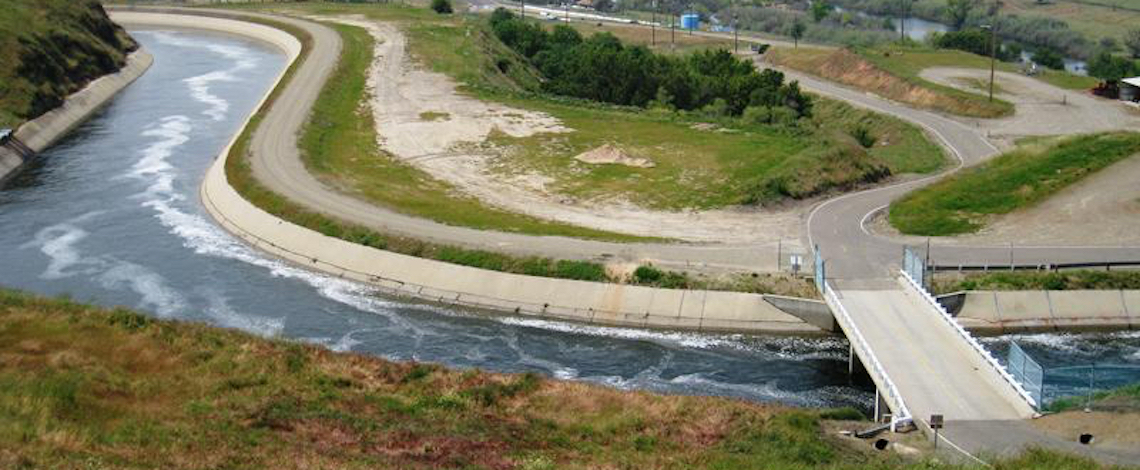
The Friant-Kern Canal seen here north of Fresno. Photo via Water Education Foundation
Written by Edward Smith
What seemed a victory for water users and power customers in California has been overturned. President Joe Biden rescinded an environmental opinion issued in the last days of the Trump Administration — an action that could have a slew of negative consequences for environmental groups and ag companies as a three-decade-old law threatens the financial viability of public utilities in Northern California.
Passed in 1992, The Central Valley Project Improvement Act brought together ag and power companies, outlining a series of programs needed to be implemented in order to protect ecosystems impacted by their water usage.
Funding for those projects would come from power and water users who use resources from the federally operated Central Valley Project. Under the language of the law, once those projects were completed, the obligation power and water users pay into the system would be halved to maintain those projects.
Instead, the annual obligations have swelled from $30 million to $54 million on average, according to the Bureau of Reclamation.
Relief from fees
In Jan. 2021, President Donald Trump’s Secretary of the Interior David Bernhardt stated in a memo that most of the projects under the improvement act had been completed and that power and water users’ obligations to the Improvement Act’s Restoration Fund would soon be reduced.
The Pacific Coast Federation of Fishermen’s Associations requested Biden to rescind the memo on entering office.
“We call on you to reverse a grave environmental injustice brought on by recent and last-minute actions of the Trump Administration by Interior Secretary Bernhardt, formerly employed by one of the biggest beneficiaries of these actions—Westlands Water District,” the letter stated. Bernhardt was a registered lobbyist for the water district before becoming Secretary of the Interior. Bernhardt has insisted the decision follows the law.
The letter from the Fishermen’s Association stated permanent diversions of water for agriculture threaten tribal homelands, fishing rights and water rights for Native American tribes from California to Washington, with impacts felt all the way to the Alaskan coast.
Water resources support migratory birds and provide critical food sources for indigenous people of Alaska.
The letter stated that unless action is taken by the Biden Administration, the economic, environmental and cultural impacts “will be difficult, if not impossible, to correct in the future.”
Becoming permanent
Paul Hauser, general manager for the Trinity Public Utilities District near Redding, said the payments have become a case of something originally meant to be temporary becoming permanent.
The actions taken by Bureau of Reclamation have not stopped fish populations from shrinking.
Biologists have pointed to factors beyond water level and temperature.
Andrea Fuller, vice president of FishBio, an environmental consulting group with an office in Oakdale, said in a previous interview the impact of predation of non-native fish species on native fish is perhaps the biggest threat salmon face. Other reports point to overfishing and climate change.
“One of the things that has frustrated me from the fisheries perspective is the sole focus on flows and exports for management and potential solutions for endangered species,” Fuller said. “I really feel that is ignoring the elephant in the room.”
Hauser said those causes are beyond the control of power and water users.
“The fact that the restoration programs have had just an abysmal record of restoring the fishery in spite of more than $2 billion spent over time, that impacts our economy,” Hauser said.
Payments into the restoration fund were never supposed to get as high as $54 million, Hauser said. He has been involved with power and water in Northern California for more than 15 years.
Language from the bill in 1992 asserts that power and water would pay no more than $30 million annually. Congress assumed, said Hauser, that fulfilling the remainder of the $50 million — set at the time — would come from other sources.
While Trinity completely relies on energy from the Central Valley Project, the Friant Dam and Friant-Kern Canal is also part of the system. The dam produces up to 25 megawatts of electricity.
Let Uncle Sam pay
Hauser said the easiest solution would be to fund the project with money from Congress.
It wasn’t until 2009 — 17 years after the passage of the act — that the Bureau published its report on program activity (CPAR) and outlined when programs would be completed.
The projects were designed to be completed within 10 years of that date, said Hauser.
“The CPAR said 10 years, we’re beyond 10 years,” said Hauser. “You can go through the list and see all these delineated actions and say, ‘what’s left?’”
A call for project proposals was sent out in 2019, according to the Bureau’s website.
The fiscal 2020 budget includes projects for fish resources, refuge water supply programs and independent programs including habitat restoration and restoration programs for the San Joaquin and Trinity rivers.
Because of how long it has taken for Reclamation to accomplish their goals, what was originally intended to not surpass $30 million has now nearly doubled because of inflation multipliers. The financial burden has threatened the viability of the current energy profile for Trinity Public Utilities District.
“Power customers are looking at no end in sight,” said Hauser.
Users are paying
It takes $85 million to operate and maintain Trinity Public Utilities District, which serves 11,000 people in rural Trinity County. Obligations to the Restoration Fund average $54 million a year, of which power users pay $29 million, on average, according to Christie Kalkowski, deputy public affairs officer with the Bureau of Reclamation. Payments depend on hydrology for the year, she said.
With no water allocations going to farmers, that means power users have to pick up their tab, said Hauser. This comes at a time when dams have reached historic lows and with less water to turn turbines, which means higher power bills for customers.
Bypasses to keep water temperatures low have become more common. This year alone, $5 million worth of power did not go through turbines, said Hauser.
Increasing costs and lower resource availability have threatened the viability of the project. Executives have to now begin considering alternate sources of energy as costs continue to climb for customers. If hydropower users switch to wind or solar, the obligations to the restoration fund would become those of water users.
Hauser said water users would not be able to bear those costs alone and a complete overhaul of the program would have to take place. This could threaten future projects as a whole.
“Water contractors can’t go out in the market to shop around like power contractors can,” said Hauser. “It would devastate the restoration activities that are happening if power walked away and I think we’re within a few years of that happening if we don’t see some real changes in the program.”








